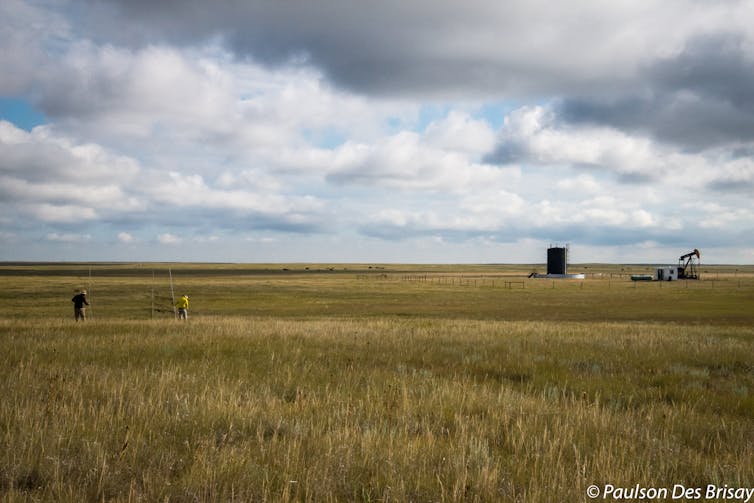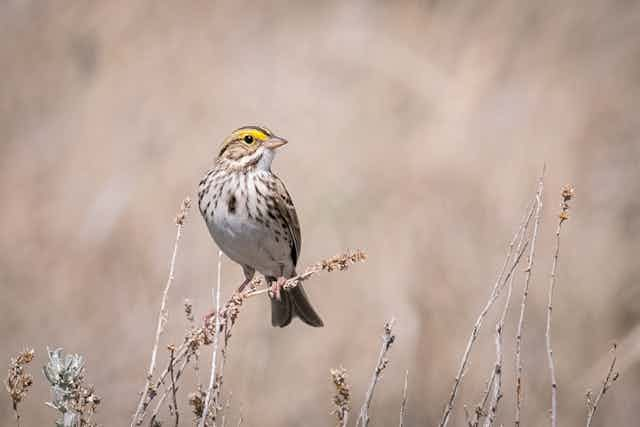Whether in cities or in oil fields, we can often hear the chirps and trills of the birds that share our spaces.
But birdsong is more than just a soothing backdrop for our activities, it is a code that birds use to tell other birds about themselves, including details about the singer’s species, identity — and sexiness.
Humans, on the other hand, fill the air and land with their own noise, disrupting the communication between birds and other animals. This means that crucial information that an animal uses for hunting, keeping an eye on predators and maintaining contact with mates and group members may be lost.
Scientists like me can figure out which aspects of a bird’s life are under threat by listening for changes to specific parts of a bird’s song. Birdsong, in a sense, is a message in a bottle.
Sending an S.O.S.
At first glance, the Canadian prairies may look empty, but the land has been heavily influenced by human activity. It has been developed into farms dotted with infrastructure used to extract oil and natural gas.
In North America, grassland songbirds are declining faster than songbirds in any other ecosystem, and activities from energy extraction may further threaten vulnerable species.
My colleagues and I recently studied the songs of Savannah sparrows in their grassland habitats in southern Alberta, near Brooks. The area is typical for a rural Canadian prairie farming town, with farms and cattle grazing mixed with native mixed-grass prairie landscapes.

We found that the birds adjusted their songs in subtle and precise ways to cope with the noise pollution produced by the machinery set up to extract natural gas and oil.
DuoLingo for Savannah sparrow songs
Bird songs are made up of many notes or syllables, with each one encoding a piece of information about the bird and its personal traits or intentions.
In this sample of a Savannah sparrow’s male song, the introductory note alerts the audience, either potential female mates or male rivals, that a performance is about to begin.
The clicks, high clusters and trills that follow are an indication of this male bird’s sexiness.
The dash syllables are used as a name or individual identifier, and the buzz syllables identify the bird as a Savannah sparrow.

As such, a bird’s song contains many types of information, just like song lyrics. A bird may be singing “Hey, hey, sexy, hey, Bob, Savannah sparrow, sexy, sexy.”
Measuring sound
When faced with noise, birds can change their tune so that they’re heard.
Measuring song pitch, or frequency, is popular among scientists when they are looking at the effects of noise pollution on birds. Birds may change the pitch of their song to move it outside the frequency range of the encroaching noise to avoid overlap, or they may lower their song pitch so that it can be heard over longer distances.
We can also measure tone, which describes how clear or whistle-like a syllable sounds to the ear. More tonal syllables sound like a clear whistle and look like a clear line on the sonogram because we (and the birds) are hearing only a small range of pitches at once.
More tonal syllables sound like this:
Less tonal syllables sound “buzzier” and less whistle-like (like the caw of a crow) and look like a thick band on the sonagram because we are hearing many frequencies at once.
Less tonal syllables sound like this:
Less tonal, “buzzier” sounds makes the singer easier to find, while more tonal sounds can be heard at farther distances.
Sounds matter
The infrastructure used to extract oil and natural gas make all kinds of different noises: Low hums, deep rhythmic pulses and high-pitch whirrs. The frequency sounds that overlap with birdsong are the ones that matter most to the birds.
In our study, we found that Savannah sparrows sang differently depending on the type of infrastructure nearby.
Birds altered their songs mostly at generator-powered screw pumps, but also made song changes at other infrastructure types. Most song changes at the screw pumps were changes to pitch or frequency. Most song changes at natural gas compressors, grid-powered screw pumps and generator-powered pumpjacks were to tonality, changing the way the whistle-like syllables sounded.
When infrastructure noise masked the birds’ sexy click syllables, the male Savannah sparrows sang them at a higher pitch. They also sang sexy high cluster and trill syllables in a buzzier, less tonal manner. Those changes should have made it easier for female listeners to locate the singing male.
These Savannah sparrows also sang the introductory notes of their songs, which attracts listeners, and the buzz syllable, which identifies the bird species, at lower pitches and in a more whistle-like tonal manner. These changes increased the distance at which their song could be heard and likely attracted more listeners.
The message matters
When faced with noise, birds can benefit from changing their songs to restore important or lost information. What that information is, exactly, all depends on what they are trying to communicate. It’s not unlike having a conversation at a loud cocktail party; you may repeat your name several times if that’s what is important to you at the time.
Grassland songbirds are in decline, and although we often think of the Prairies as a quiet place, noise may be contributing to the lower mating success seen in some grassland birds.
Even though we know that the birds we heard changed their songs, we don’t yet know if it was an effective strategy because that depends on whether the changed song is heard or understood by their audience. It’s also possible that the audience will no longer respond to the changes.
Our next step is to find out if the Savannah sparrow song changes are effective. We will be playing back modified bird calls to female and male audience members and see how they respond, which in essence, is like talking to the birds themselves.

